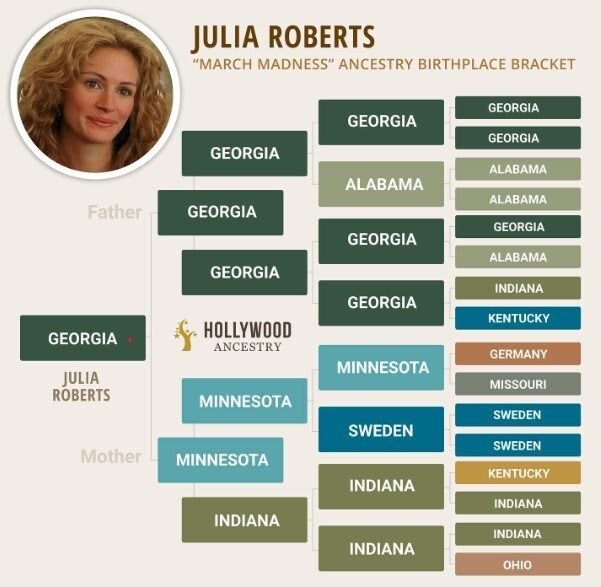
20 Apr Newsletter- April 20, 2024
Contents
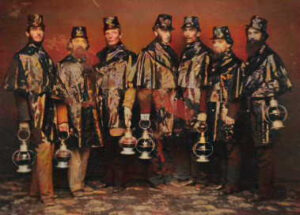 BEFORE THERE WAS WOKE THERE WAS WIDE AWAKE
BEFORE THERE WAS WOKE THERE WAS WIDE AWAKE
The Wide Awakes were a youth organization and later a paramilitary organization cultivated by the Republican Party during the 1860 presidential election in the United States. The organization introduced many to political participation through popular social events, an ethos of competitive fraternity, and even promotional comic books. It proclaimed itself as the newfound voice of younger voters. The structured militant Wide Awakes appealed to a generation profoundly shaken by the partisan instability in the 1850s, offering young northerners a much-needed political identity.
In early March 1860, Abraham Lincoln spoke in Hartford, Connecticut, against the spread of slavery and for the right of workers to strike. Five store clerks, who had started a Republican group called the Wide Awakes, decided to join a parade for Lincoln, who delighted in the torchlight escort back to his hotel provided for him after his speech. Over the ensuing weeks, the Lincoln campaign planned to develop Wide Awakes throughout the country and to spearhead large voter registration drives since they knew that new and young voters tend to embrace new and young parties.
The New York Times described the Wide Awakes as “young men of character and energy, earnest in their Republican convictions and enthusiastic in prosecuting the canvass on which we have entered.” In Chicago, on October 3, 1860, 10,000 Wide Awakes marched in a three-mile procession. By the middle of the 1860 campaign, Republicans bragged that they had Wide Awake chapters in every northern (free) state county. On the day of Lincoln’s election as president, Wide Awakes had grown to 500,000 members. The group remained active for several decades.
The standard Wide Awake uniform was a full robe or cape, a black glazed hat, and a torch six feet long to which a large flaming pivoting whale oil container was mounted. Its activities were conducted primarily in the evening and consisted of several night-time torch-lit marches through cities in the northeast. The Wide Awakes adopted the image of a large eyeball as their standard banner.
In August 1860, a political rally was scheduled to be held at Stone’s Prairie in Adams County, Illinois, near the modern village of Plainville. This area, in the far west of Illinois, was familiar to two of the presidential candidates. Although the Republican candidate, Abraham Lincoln, was known in the area, his Democratic opponent, Stephen Douglas, had practiced law nearby. In addition to local animosity, Adams County was close to the border with Missouri, a slave state.
The rally was organized by the Republicans. When it was initially announced, there was an invitation to Democratic speakers. Although the invitation was later withdrawn, that fact was not widely disseminated, which resulted in confusion as to whether it was to be a Republican rally or a debate between Republican and Democratic supporters.
During the 1860 campaign, it was common for settlements to raise poles as much as 150 feet (46 meters) high. The political parties hung flags and effigies of the candidates they opposed from the poles.
On the way to the rally, the Quincy Wide Awakes passed through Payson, the residents of which had erected a pole with an offensive effigy of Lincoln astride a rail. The Wide Awakes, however, carried a banner with an equally offensive depiction of a drunken Douglas falling over a pile of rails. An early confrontation was avoided, with the Wide Awakes proceeding to Stone’s Creek.
The August 25, 1860, rally involved around 7000 participants. Democrats appeared expecting to hear their candidates in a debate. They were instead treated to a podium of Republicans, whom they mocked. The Wide Awakes defended the speakers, and a general melee involved several hundred men.
After the rally, the Wide Awakes returned through Payson, where they found a hundred Democrats guarding their pole. Although Wide Awakes avoided confrontation, shots were fired at them while they left town. Shots pierced the Wide Awakes’ flag, and several were reported to have been injured.
To the South, the Wide Awakes were only a taste of what would come if Lincoln were elected. The North would not compromise and could force themselves upon the South. “One–half million men uniformed and drilled, and their organization’s purpose is to sweep the country where I live with fire and sword.” The wide acceptance of the Wide Awakes in the North did not appease that mindset. On October 25, 1858, Senator Seward of New York stated to an excited crowd that “a revolution has begun” and alluded to Wide Awakes as “forces with which to recover back again all the fields… and to confound and overthrow, by one decisive blow, the betrayers of the constitution and freedom forever.” To the South, the Wide Awakes and the North would be content only when the South was fully dominated.
The South recognized the need for their own Wide Awakes. It thus started a movement to create “a counteracting organization in the South,” dubbed the “Minutemen,” after the Patriot militias of the American Revolution of the same name. The South viewed the Wide Awakes as the North’s private army and determined to create their own. It would no longer entertain the “abhorrence of the rapine, murder, insurrection, pollution, and incendiarism which have been plotted by the deluded and vicious of the North, against the chastity, law, and prosperity of innocent and unoffending citizens of the South.” The Minutemen were the South’s unofficial army. Like that of the Wide Awakes, they were expected “to form an armed body of men… whose duty is to arm, equip and drill, and be ready for any emergency that may arise in the present perilous position of Southern States.” The fear of the Wide Awakes resulted in Minutemen companies forming all over the South. Like their enemy, they too held torch rallies and wore their uniforms, complete with an official badge of “a blue rosette… to be worn upon the side of the hat.”
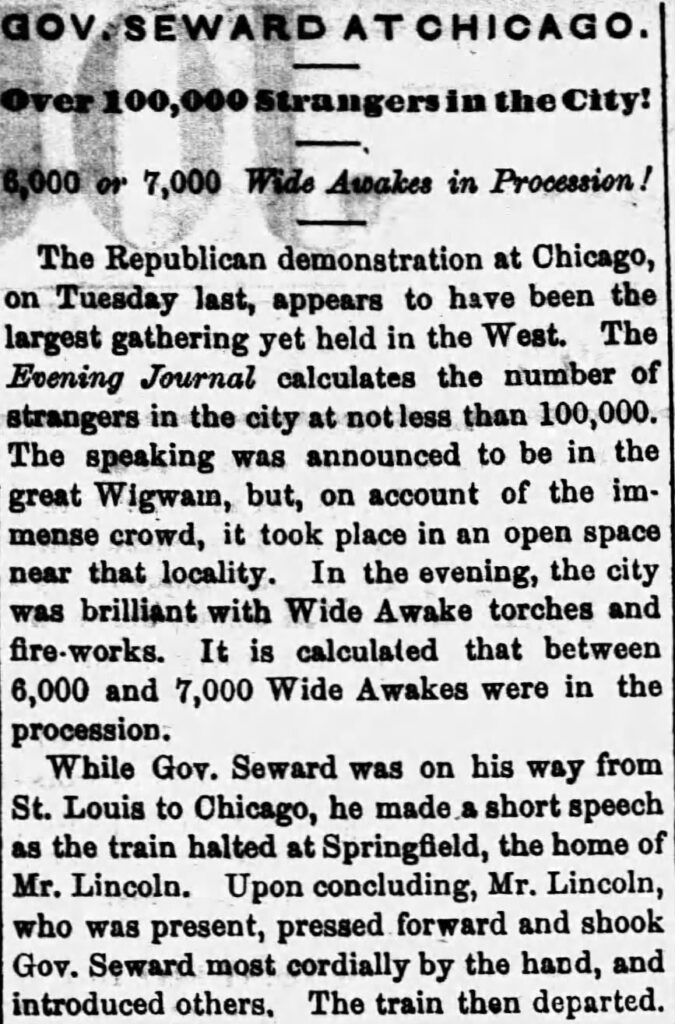
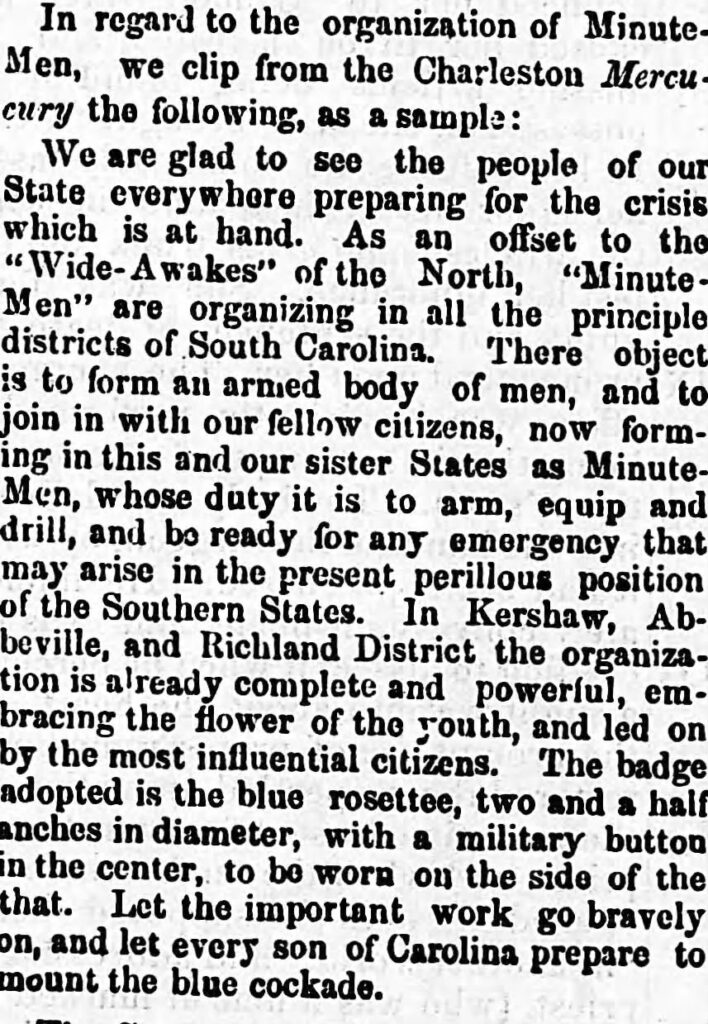
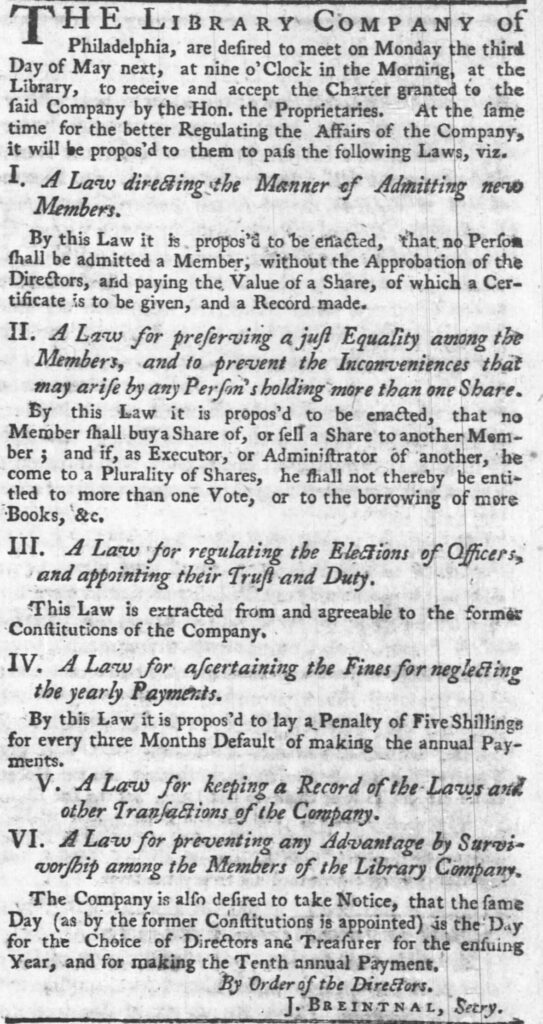 BENJAMIN FRANKLIN AND THE START OF LIBRARIES
BENJAMIN FRANKLIN AND THE START OF LIBRARIES
The Junto, also known as the Leather Apron Club, was a club for mutual improvement established in 1727 by Benjamin Franklin in Philadelphia. The Leather Apron Club debated questions of morals, politics, and natural philosophy and exchanged knowledge of business affairs.
Franklin organized a group of friends to provide a structured form of mutual improvement. Initially composed of twelve members, the group called itself the Junto (from the Spanish word junta or assembly). The members of the Junto were drawn from diverse occupations and backgrounds, but they all shared a spirit of inquiry and a desire to improve their community and help others. The original members were printers, surveyors, cabinetmakers, clerks, and bartenders. Although most members were older than Franklin, he was their leader.
At just 21, he oversaw five men, including Hugh Meredith, Stephen Potts, and George Webb, who were soon to form the core of the Junto. Franklin was an outgoing, social individual and had become acquainted with these businessmen. This gathering included prominent merchants who met informally to drink and discuss the business of the time. Franklin’s congenial ways attracted many unique and learned individuals; from these, he selected the members for the Junto.
All members lived in Philadelphia and came from diverse areas of interest and business. Along with Meredith, Potts, and Webb, they included Joseph Breintnall (see the story below), merchant and scrivener, who also loved poetry and natural history. Thomas Godfrey was a glazier, mathematician, and inventor; Nicholas Scull II and William Parsons were surveyors. Scull was also a bibliophile, and Parsons was a cobbler and astrologer. William Maugridge was a cabinetmaker, William Coleman was a merchant’s clerk, and Robert Grace was a gentleman. Grace’s wealth meant he did not have to work, but apparently, he brought an intellectual element to the group and a fine library. The twelfth member of the Junto remained a mystery until 2007 when Professor George Boudreau of Penn State discovered a long-forgotten account of the club’s refreshments and verified that shoemaker John Jones Jr. was an original member. Jones was a Philadelphia Quaker, a neighbor of Franklin’s, and later a founding member of the Library Company of Philadelphia. The club met on Friday nights, first in a tavern and later in a house, to discuss the day’s moral, political, and scientific topics.
Franklin describes the formation and purpose of the Junto in his autobiography:
I should have mentioned before that, in the autumn of the preceding year, [1727], I had formed most of my ingenious acquaintances into a club of mutual improvement called the Junto; we met on Friday evenings. The rules that I drew up required that every member, in his turn, should produce one or more queries on any point of Morals, Politics, or Natural Philosophy to be discussed by the company and, once in three months, produce and read an essay of his writing, on any subject he pleased.
Our debates were to be under the direction of a president and to be conducted in the sincere spirit of inquiry after truth, without fondness for dispute or desire of victory, and to prevent warmth, all expressions of positiveness in opinions, or direct contradiction, were after some time made contraband, and prohibited under minor pecuniary penalties.
I even forbid myself, agreeably to the old laws of our Junto, the use of every word or expression in the language that imported a fixed opinion, such as certainly, undoubtedly, etc., and I adopted, instead of them, I conceive, I apprehend, or I imagine a thing to be so or so, or it so appears to me at present.
Here’s a bit more on the Library Company of Philadelphia:
Library Company of Philadelphia
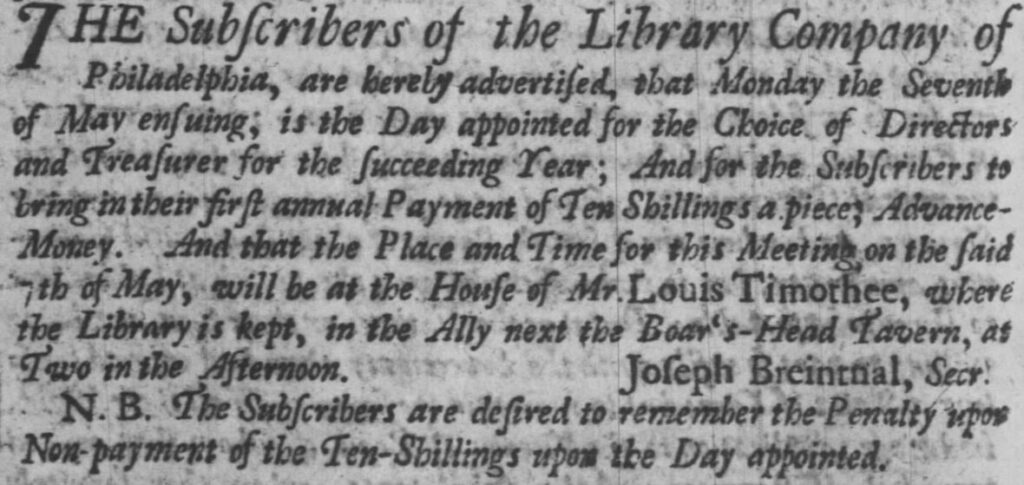 FRANKLIN’S FRIEND WAS SNAKEBIT
FRANKLIN’S FRIEND WAS SNAKEBIT
Joseph Breintnall was an influential American merchant and amateur naturalist. He was the first Secretary of the Library Company of Philadelphia and the sheriff of Philadelphia from 1735 to 1738. His name is usually remembered alongside that of his friend and collaborator, Benjamin Franklin. An early member of Franklin’s Junto, Breintnall co-authored a series of letters with Franklin under “The Busy-Body.” The 32 letters were printed serially in Andrew Bradford’s newspaper, The American Weekly Mercury, in 1729.
Breintnall was a copyist and a merchant who opened a public house called “The Hen and Chickens”. He was married under the care of the Religious Society of Friends (Quakers) in 1723. Breintnall’s observations of the aurora borealis and detailed account of being bitten by a rattlesnake were circulated within the Royal Society in London through his correspondence with the Quaker botanist and Fellow of the Royal Society, Peter Collinson. Breintnall also experimented with printing techniques, especially nature printing. His name appears several times in the Philadelphia Monthly Meeting of Friends records. He died in 1746 and left no will.
I was unsuccessful in finding a transcription of his detailed account of the rattlesnake bite, but I found the article below.

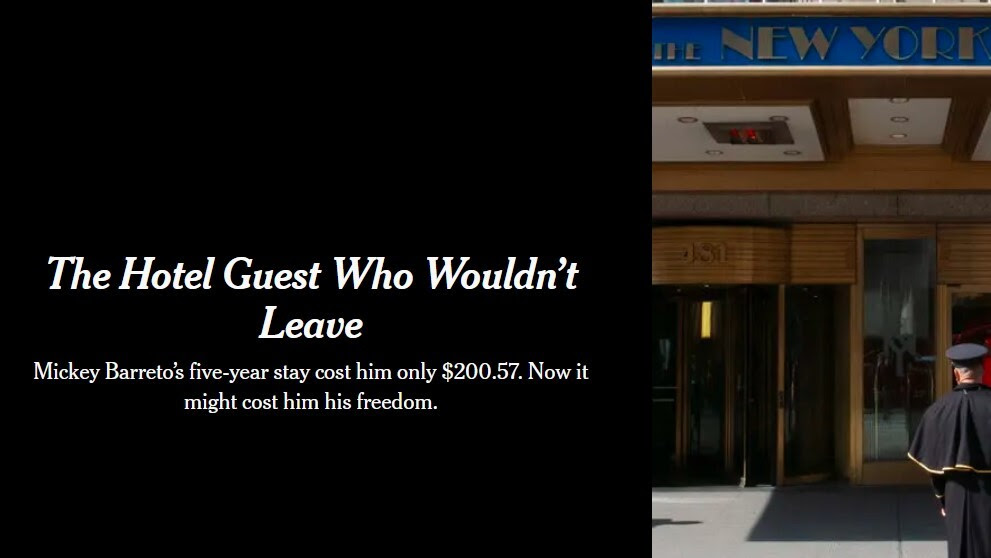 “NYC MAN SPENT $200 FOR A FIVE-YEAR STAY AT THE NEW YORKER HOTEL”
“NYC MAN SPENT $200 FOR A FIVE-YEAR STAY AT THE NEW YORKER HOTEL”
You likely saw this article, but the part that caught my eye was:
But in recent years, he developed an obsession with his genealogy, claiming to have uncovered a direct connection to Christopher Columbus through Portuguese royalty. In Civil Court, he started to invoke the explorer’s name — “My family name ‘Muniz Barreto Columbus,'” he wrote in a 2021 filing.
I looked to see if there were any verifiable descendants of Christopher Columbus, and this person seems to be the most well-known descendant:
Cristóbal Colón de Carvajal y Gorosábel, 18th Duke of Veragua, 17th Duke of la Vega, 19th Marquess of Aguilafuente, 16th Marquess of Jamaica, 20th Admiral of the Ocean Sea, GE, OIC (born 4 October 1949) is a Spanish nobleman, businessman and formerly an officer, helicopter pilot, and commander of a naval vessel in the Spanish Navy. He is a direct descendant of Christopher Columbus by way of Christopher’s son, Diego. From Diego, Colón de Carvajal also holds the Duchy of Veragua since 1986. As the Duchy corresponds to the present-day Veraguas Province of the independent republic of Panama, Colón de Carvajal maintains close connections with Panamanian society and serves on the advisory board of Petaquilla Minerals, a mining company.
In 1986, Colón inherited from his father, the 17th Duke of Veragua, all of his titles after he was murdered by the Basque nationalist and separatist organization ETA.
Cristóbal Colón de Carvajal, 17th Duke of Veragua
In 2011, his additional title as Duke of la Vega was among many to be passed on to different successors, with the new Duke of la Vega being Colón’s son, Ángel Santiago Colón de Mandalúniz.
In 1992, to commemorate the 500th anniversary of Columbus’ landing on Hispaniola, Colón de Carvajal was co-designated Grand Marshal of the Tournament of Roses Parade alongside US Congressman Ben Nighthorse Campbell.
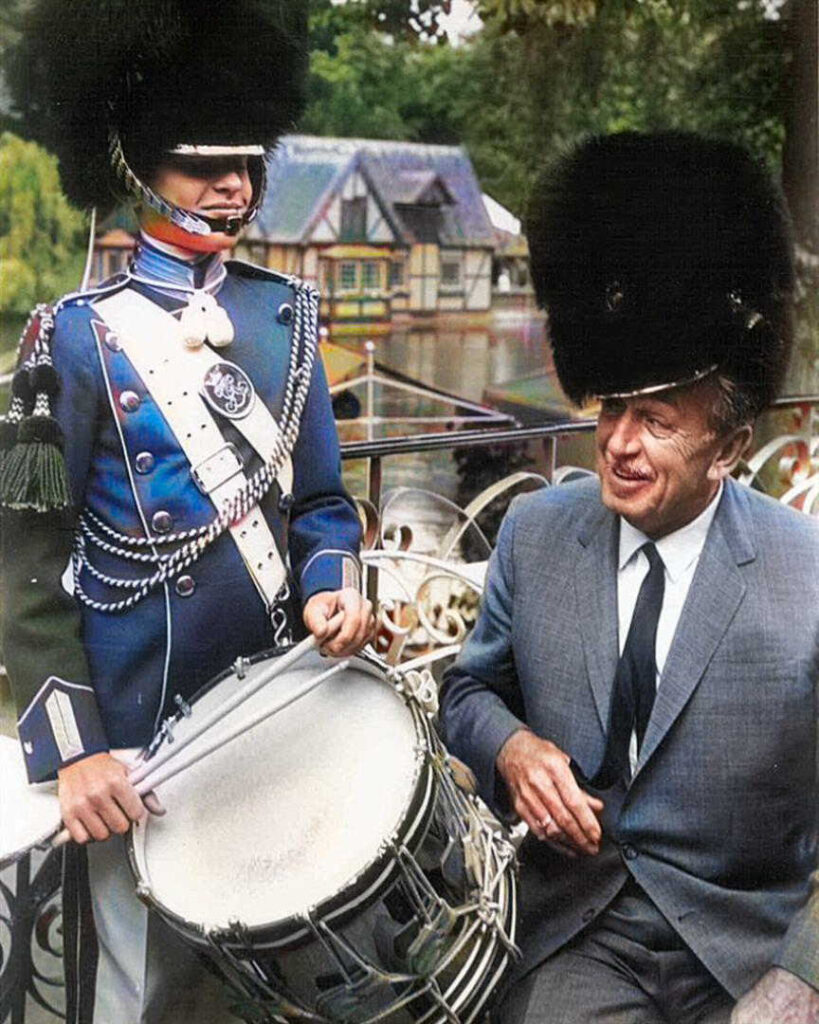 THE LITTLE MERMAID AND THE MOUSE
THE LITTLE MERMAID AND THE MOUSE
We visited Tivoli Gardens in Copenhagen a couple of years ago. The park was created when Tivoli’s founder, Georg Carstensen, obtained a five-year charter to create Tivoli. He received the charter by convincing King Christian VIII that “when the people are amusing themselves, they do not think about politics”. Georg Carstensen created Tivoli from the inspiration of parks and gardens worldwide.
On August 15, 1843, the garden gates opened for the first time. Guests were immediately impressed by the elegant and exotic gardens (giving the park the name Tivoli Gardens). The famous writer Hans Christian Andersen was one of the impressed guests Tivoli inspired to write the fairy tale “The Nightingale.”
During the Nazi occupation of Denmark in World War II, large parts of Tivoli were sabotaged and burned down. The park was closed for several weeks, rebuilt, and reopened. The park has changed throughout the years, from the effects of war to new rides and updates. Tivoli’s wooden roller coaster (1914) is one of the oldest wooden roller coasters still operating worldwide.
Walt Disney visited Tivoli several times (pictured above in 1964), where “he was fascinated by the mood and atmosphere”. It was the ambiance of Tivoli that Walt wanted to incorporate into his amusement park. In 1955, the original Disneyland opened in California, thanks to inspiration from Tivoli. Walking around Tivoli, it is easy to see some similarities between the parks, from similar rides to the Epcot “around the world” feel as you pass oriental palaces and a German side street.
The article below is from 1931.
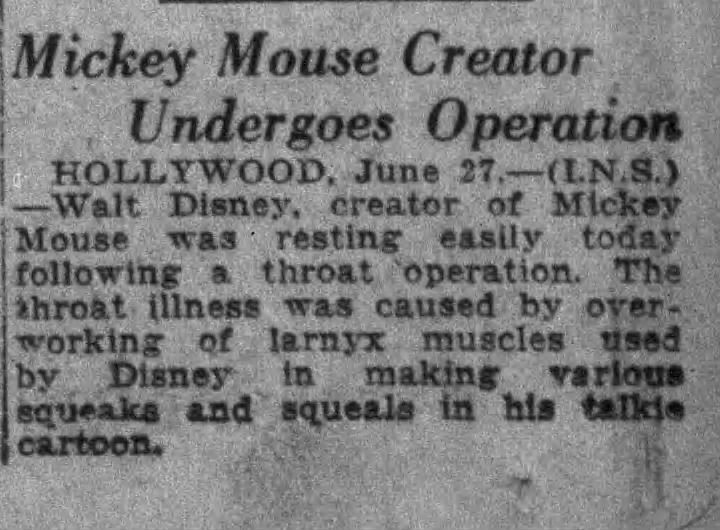
SOME MISCELLANEOUS LINKS TO INTERESTING PAGES:
SIX BADASS LIBRARIANS WHO CHANGED HISTORY
WHEN HUGE STORIES GET KNOCKED OFF THE FIRST PAGE
FAMOUS PEOPLE ALIVE AT THE SAME TIME IN HISTORY!
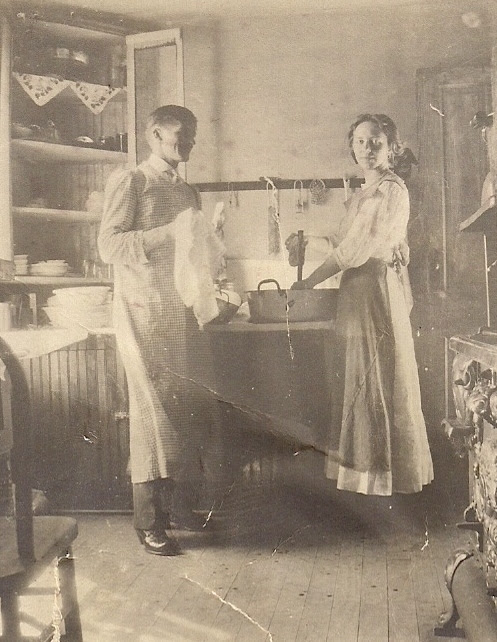 WHAT ABOUT YOUR ANCESTORS?
WHAT ABOUT YOUR ANCESTORS?
Reach out to Dancestors Genealogy. Our genealogists will research, discover, and preserve your family history. No one is getting any younger, and stories disappear from memory every year and eventually from our potential ability to find them.
Preserve your legacy, and the heritage of your ancestors.
Paper gets thrown in the trash; books survive!
So please do not hesitate and call me @ 214-914-3598 and get your project started!

